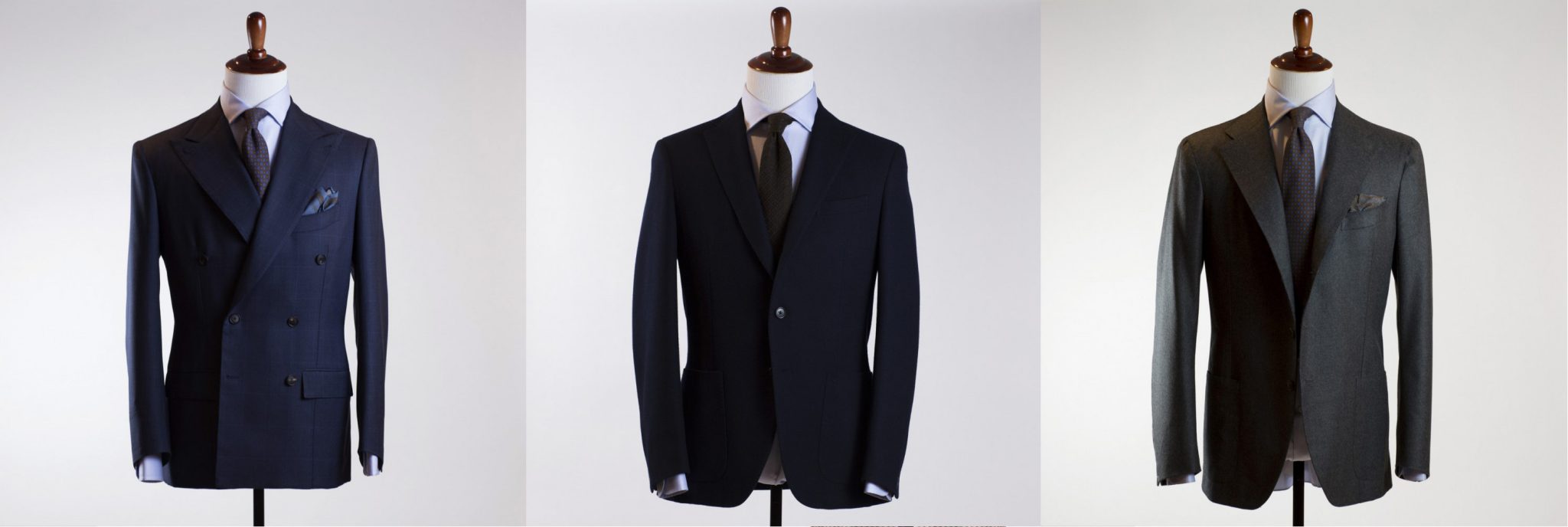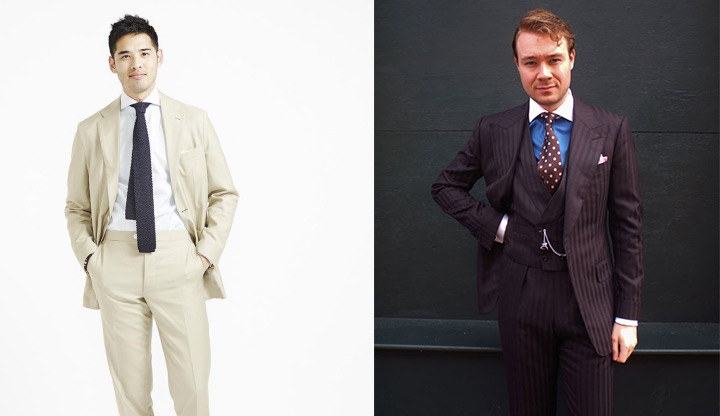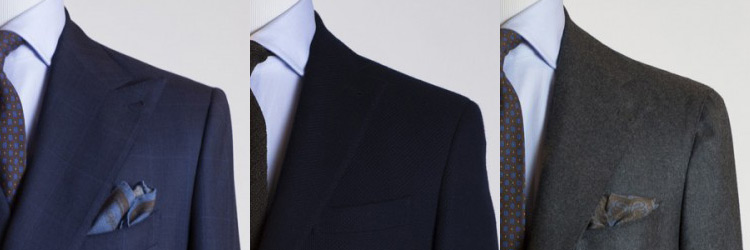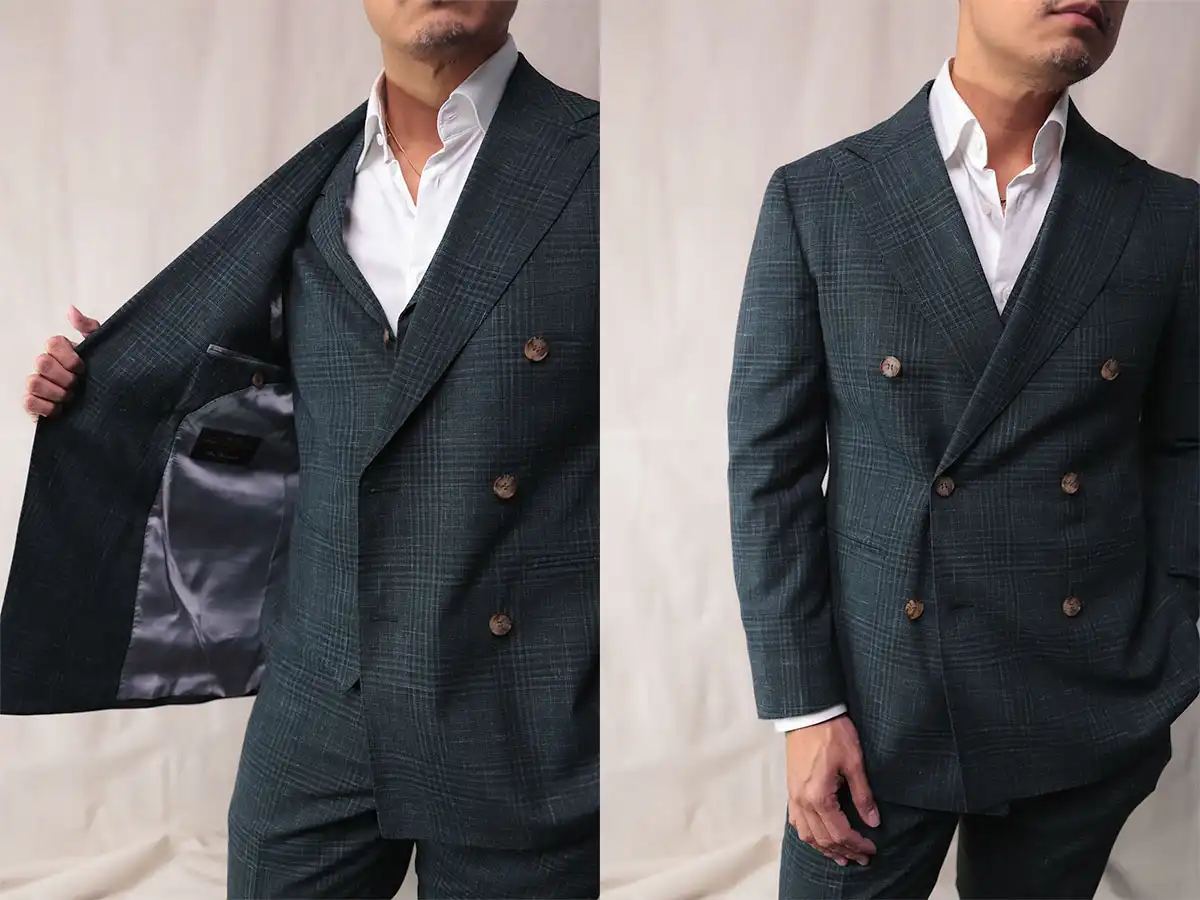So you’ve got a dressy event coming up, and you need to know how to buy a suit that fits you well. Got it! Before you whip out that credit card, did you know not all
You probably thought as long as you know your size, you can buy any suit and it’ll fit you well. Sadly, that’s not always true, so we put together this quick guide to suit fit types.
In this article, we’re laying out a high-level overview of the different styles and details you may find when shopping. And there’s a good chance you may not have even been aware of these things if it’s your first time buying a suit.
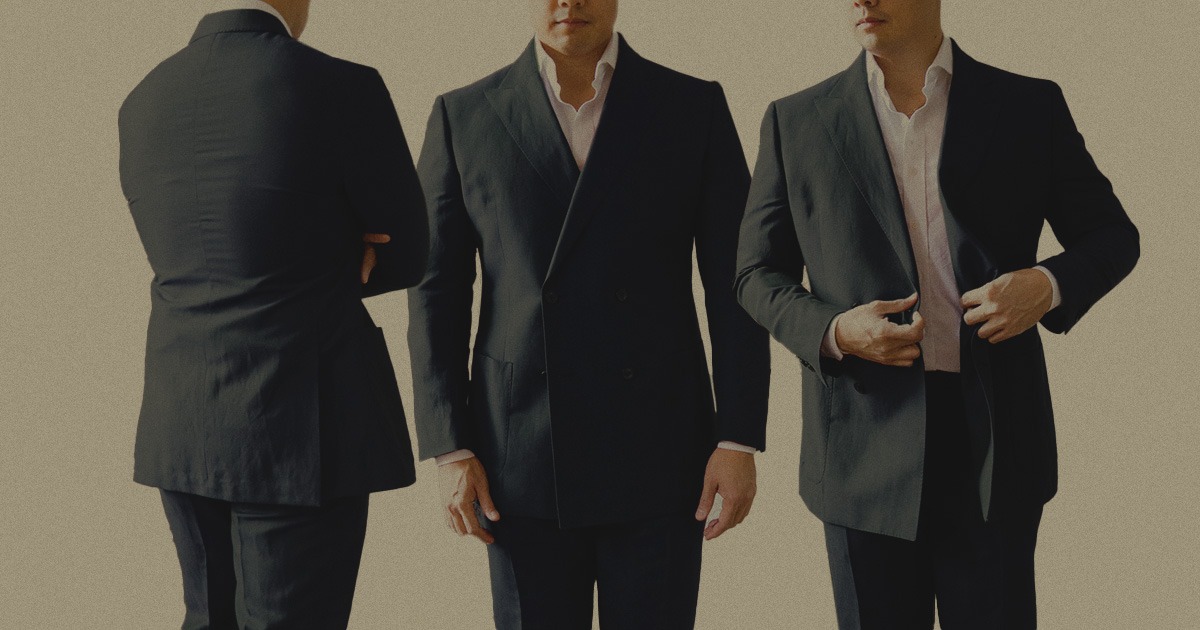
A Suit’s Silhouette, and Why It Matters
In a word, what we’re looking at is a suit’s (or sport coat’s) silhouette and the way it was designed and constructed.
There’s a lot that goes into a suit’s pattern that affects how it lays on your body, and how it looks when you wear it. Some silhouettes may work better for your build than others. That’s why you can’t just buy your size and assume it will fit you well.
So let’s identify the different design elements of a suit’s silhouette, and how to choose the best characteristics for your body type.
Once we’re done, you’ll be able to mix and match these elements to come up with a silhouette that best
What is a suit’s silhouette?
The way a suit’s lines and proportions work with each other define its silhouette.
You also want to consider visual form, a suit’s overall look once the pieces are cut, sewn, and stitched together by a tailor 1.
The whole idea behind tailoring (and clothing in general) is to accentuate your body’s positives and minimize its negatives. And so a tailor chooses the right elements to construct a visual form that produces a garment whose silhouette flatters your physique.
Makes sense?
That’s how good tailoring can make a man seem like he’s lost ten pounds, or appear taller than he actually is.
For the purposes of this article, I’m going to simply use one term: silhouette. Just keep in mind that “silhouette” represents everything we chatted about in the section above.
British, American, Italian Style Suits ?
You may have heard of different silhouettes described based on region2.
For example:
- British cut typically equates to structured shoulders, fuller chests, and suppressed waists
- Italian cut usually refers to natural shoulders, higher gorge, and slim waist
- American cut would typically be sack style, relaxed shape, natural, minimally-padded shoulders
Instead of looking at these silhouettes as a whole and relating them to a specific region, I’m going to try and break down individual characteristics. That way, you can identify them more easily.
So the next time you’re out looking at
Body Type and Balance: Two things to remember
Always keep in mind these two things. This applies not only to
- You must dress for your body type. Look at your body objectively, and use the elements below to understand which complements your body best.
- You are trying to achieve balance. By accentuating the positives and minimizing the negatives, you get closer to achieving that balance.
How A Suit Drapes
Before individual stylistic choices are made, one thing that must first be considered is drape.
Drape, in this instance, refers to how the suit lays against the body. Several things can affect drape: fit, body proximity, and fabric choice 3.
The first is obvious: If your fit is imperfect, drape and silhouette won’t matter.
Body proximity refers to how closely the jacket and trousers mimic the lines of your body. In other words, how “slim” or “relaxed” is each garment? Think of the relaxed, looser style of American sack suit, versus the structured, slimmer British cut suit.
Depending on your body type, you have to choose the amount of slimness carefully, otherwise, you can compromise fit and drape.
Your fabric choice also affects how the final product drapes. Again, depending on your body type and the silhouette you’re trying to achieve, certain fabrics may work better than others.
And consider a fabric’s weight. An lightweight worsted wool jacket will drape differently than a winterweight tweed jacket, for instance.
The elements that affect a suit’s silhouette
Structured vs. Soft
Overall, how does the jacket look? Generally, suit jackets have either a structured or a soft look.
Structured jackets have well-defined, military-inspired shoulders, stiffer canvas interlining, and significant waist suppression, forming that nice, solid V upper-body shape.
Soft jackets are generally more relaxed, have a natural shoulder (little to no padding), lighter interlining (or none at all), and are slim overall, possibly with a bit of waist suppression.
Elongating vs. Widening
Does the suit elongate you, making you look taller and leaner? Or does it make you look wider?
Remember, you’re looking to achieve balance.
If you’re naturally tall, you most likely don’t want a suit that elongates you. And if you’re a bigger guy, or have an athletic build with a thick chest and back, you probably don’t need to look any wider than you already are.
The opposite is true if you’re a shorter man; you want to maximize the appearance of height, therefore, you want a silhouette that elongates you. And if you’re of smaller stature with narrow shoulders and small chest, you want to find a silhouette that maximizes the appearance of width.
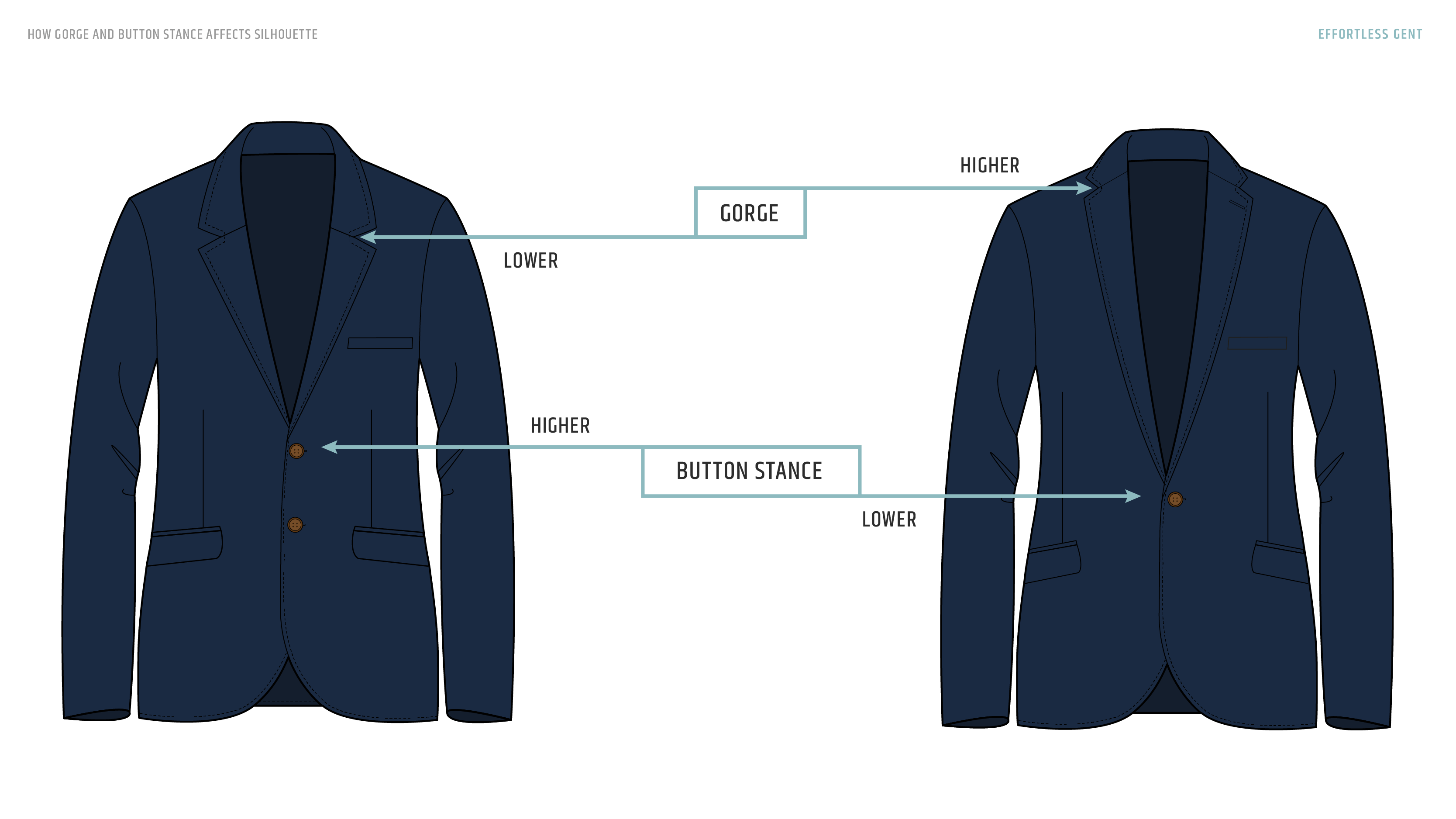
One way that a suit jacket can maximize the appearance of height is to have a higher gorge—the point where your suit collar and suit lapel meet—and a lower button stance.
The opposite effect occurs when you have a lower gorge and higher button stance. Apply one or the other (or both) to “shrink” your torso and minimize the appearance of height.
The elements that help widen your silhouette? Wider lapels, higher gorge, and slightly extended, structured shoulders, and a suppressed waist all give the appearance of a wider upper body.
Regarding gorge positioning: Interestingly enough—I realize this may sound contradictory—gorge positioning can both elongate and widen a silhouette.
How? It transfers the visual weight from the chest and adds it to the shoulders, which lengthens the torso. At the same time, this makes the shoulders appear broader (a widening characteristic).
Overall, this creates the ideal V shape most men want, and rightfully so. (Hat tip to Tanner at Masculine Style for this distinction.)
Leanness vs. Fullness
How “lean” or “full” a jacket is generally refers to how close it sits to the body. While all jackets should fit well, slim isn’t the only option (and therefore isn’t the only way to wear a jacket).
There are three distinct areas to pay attention to:
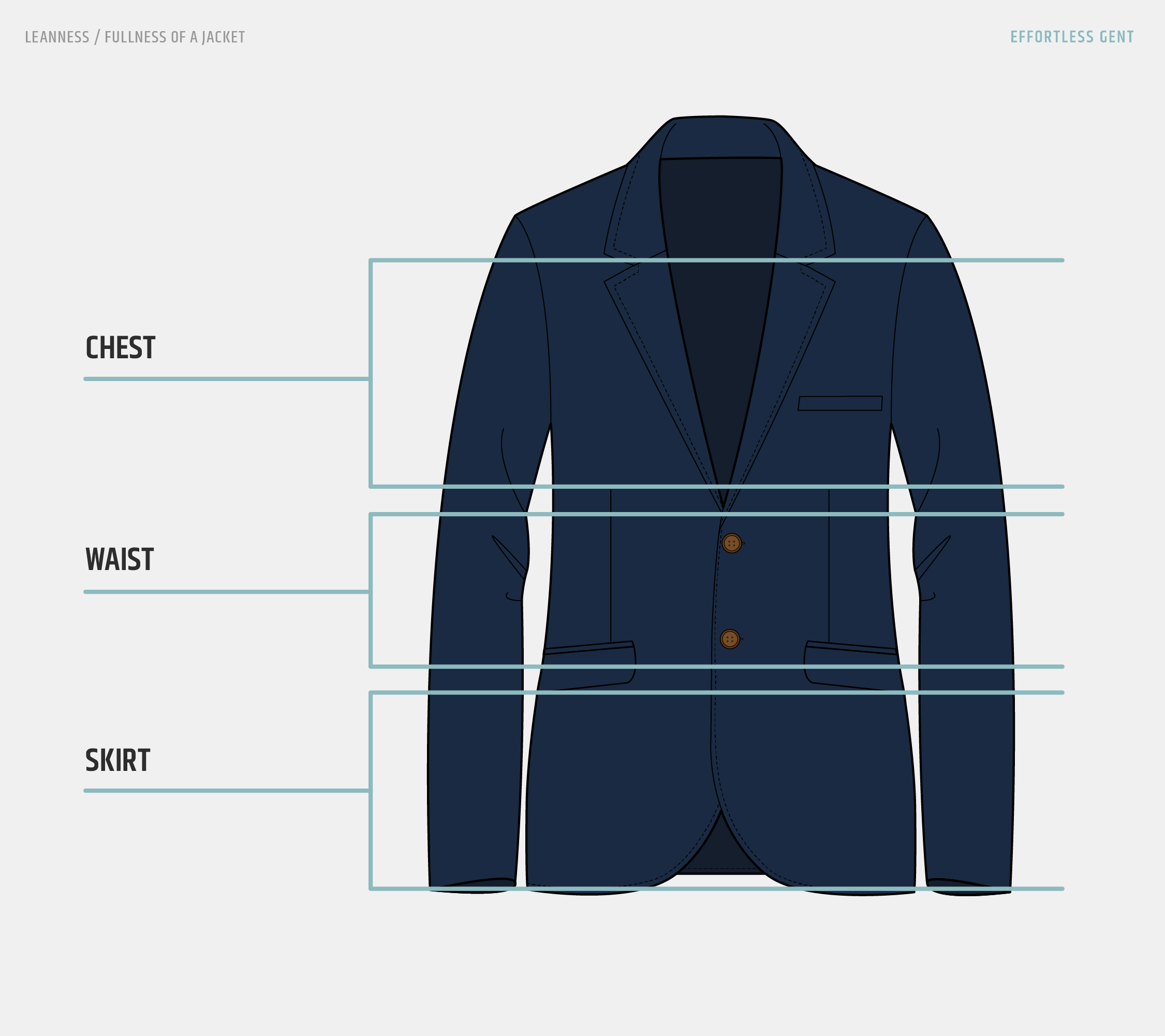
- Chest: A lean chest is shallow and sits straight on the wearer, while a full chest has more… well, fullness. It gives the appearance of structure and a built-up chest.
- Waist: A suppressed (or nipped, or tapered) waist is close to the torso when buttoned, a full waist has more room, such as the American sack style.
- Skirt/Seat: A lean skirt (the area below the buttoning point on a jacket) hugs the hips, while a full skirt is drawn away from the hips.
Shoulder Detail
Here, we’re talking about the area where the shoulder meets the sleeve.
While there are other styles of shoulder expression4, I wanted to focus on the three most common: Roped, Natural, and Bald.
Roped shoulders have a distinct ridge; it literally looks like a rope was sewn underneath the fabric along the lifted crown.
Natural shoulders also have a ridge, though not as prominent, and the crown is flatter than the roped example.
Bald shoulders have no visible ridge and are knocked down, similar to a woven
Regarding shoulder formality: There’s certainly room for argument here, but in general, structured shoulders are considered more formal, while natural and bald shoulders are more casual.
Regarding shoulder padding: Depending on your actual shoulders, the amount of padding can either work in your favor, or against you.
So should you choose a jacket with built-up padding, lighter padding, or minimal/no padding at all?
It depends if your shoulders are square, average, or sloped.
Square shoulders won’t need as much (or any) padding to maintain the correct shape of the jacket, while sloped shoulders will need some padding to help maintain that shape.
This padding can also help our sloped-shouldered friends minimize the inevitable collar gap that can occur.
Average shoulders have the most leeway when it comes to padding, though I’d advise against minimal padding to keep it the most neutral.
Fabric Weight, Color, and Design
In general, though not always the case, heavier, more substantial fabrics lend themselves to more structured silhouettes, while lighter-weight fabrics are better suited for soft silhouettes.
Also consider the canvas interlining. A heavy canvas equates to a more structured silhouette, and a lighter canvas, a softer one.
Naturally, you don’t find heavy canvassing in suits made from lighter fabrics like linen (these are often half-canvassed at most, and unstructured, to minimize heat and weight).
If you’re at a knowledgable shop, the sales associate should be able to tell you which weight was used on the jacket you may be interested in if you’re unsure.
Button Style, Stance, and Amount
Single-breasted, two button jackets help to elongate the torso (especially with a lower button stance) and minimize the visual break-up, which is great for shorter men.
Double-breasted jackets with a 6×2 configuration—six buttons total, two can be fastened—create more visual break-up, but can also make you appear wider than a single-breasted jacket does.
Choosing the best silhouette for you
You can combine each of your preferred characteristics to create a custom silhouette of your own, one that both speaks to your style and flatters your body type.
In case it isn’t obvious, a suit can make a man look shorter or taller, wider or slimmer. It all depends on your goal, and how the different elements come together to form the suit’s final look.
Keep in mind you should always dress for your body type, strive for balance, and then apply your preferences where appropriate.
This means that if you’re a bigger, taller, or more muscular guy with broad shoulders, your suit’s characteristics will be different from that of a tiny and slender boy band member.
Here are a few (very general) examples from GQ a few years back:
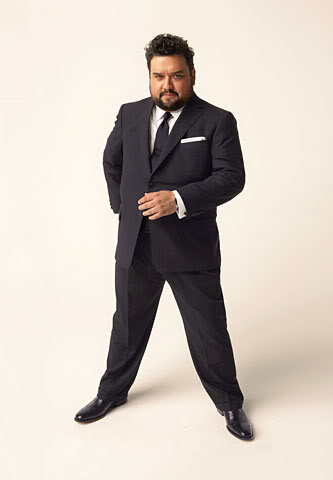
If you’re a big guy (round, or extreme dad bod)
Goal: To minimize appearance of size.
Try: Dark, solid colors, moderate lapels (on the wider side of average), nipped, although not overly-tight waist, skirt away from hips.
Photo via GQ
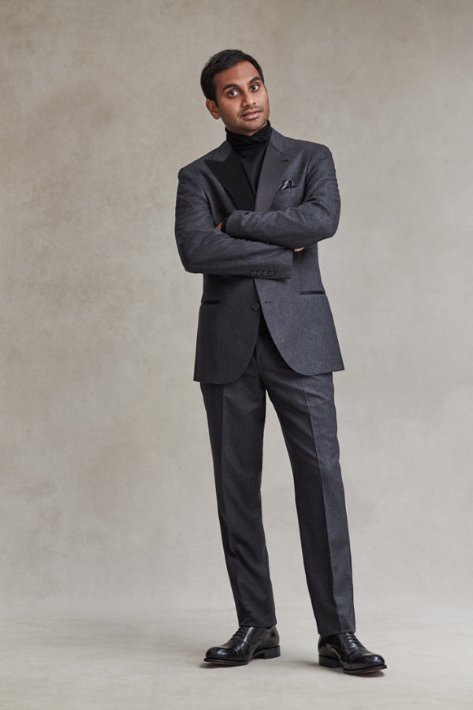
If you’re a slim guy (narrow chest, skinny torso)
Goal: Widening, for visual balance.
Try: Structured jacket shoulders, a fuller, wider chest to give the appearance of more size, higher armholes, and lapels on the slim side of average.
Photo via Mr. Porter
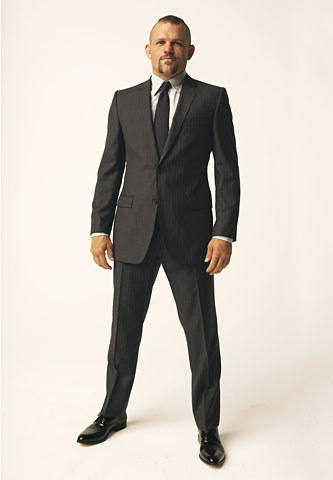
If you’re an athletic guy (broad shoulders, big chest, small waist)
Goal: Highlight good shape while still looking balanced.
Try: Soft silhouette, no excessive padding at shoulders, a lean cut chest, average lapel width, average gorge (not too high, otherwise will widen the appearance of your chest and shoulders).
Photo via GQ
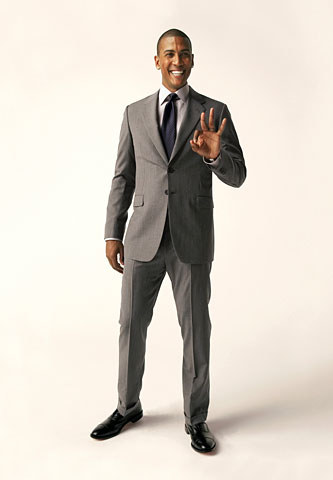
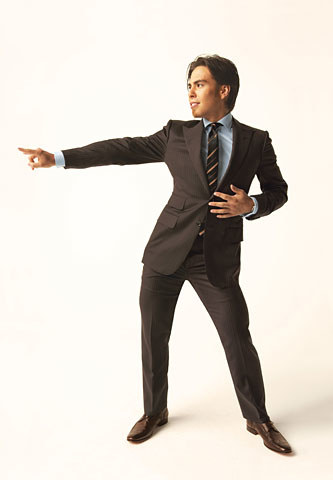
If you’re a short guy
Goal: Increase the appearance of height.
Try: Structured shoulders, higher armholes, higher gorge, lower button stance. Jacket itself shouldn’t be too long (just covering butt) to balance out height. Suppressed waist, solids or vertical pinstripes would work, higher rise on trousers to extend appearance of leg, accessorize with elements that draw the eye up.
Photo via GQ
What if you prefer a certain style or silhouette?
There is room for preference here, although, you want to make sure you’re not swinging too far in any one direction when it comes to the optimal proportions and styles for your body shape.
Find your middle ground first, and then deviate from there.
So if you’re a big, rotund guy, for instance, and you want to minimize your girth, choosing a vibrant glen plaid with an overcheck may not be the best pattern for you. Although this doesn’t mean you can’t ever wear pattern.
A safe choice would be a more darker, solid fabric, and for pattern, play with something at a smaller scale with minimal contrast, such as birdseye or a herringbone.
Is bespoke or custom the only way to achieve the perfect fit?
Bespoke is your number one option if you have a highly-specific set of customizations you want to achieve.
If you’re somewhat flexible, you can find a ready-to-wear brand that creates
Brands such as SuitSupply have models that mimic both English and Neapolitan styling, you’ll just have to wade through their 11 or so models to decide which one fits you best. You can also check out my in-depth review of their Custom / Made to Measure service.
Another brand I’ve found to fit well on different body types is Spier & Mackay. It’s currently my number one recommendation for affordable, well-made
Spier & Mackay was founded on the belief that great fit and high quality don't have to be luxuries.
Parisian Gentleman did a round-up of worthy ready-to-wear options a few years back.
For American-style cuts, you need to look no further than the standards of Brooks Brothers and J.Press to satisfy your more trad sensibilities.
Made-to-measure is also an option, although, you’d probably have to work with the company to get the details right. Make sure the shop already creates styles that are already very similar to the silhouette you’re trying to achieve.
Oliver Wicks and Lanieri are great options. Check out our MTM reviews here.
Articles of Style is a great higher-end, made-in-America option for online MTM, and their fit process is incredibly easy.
Beckett & Robb is an MTM shop that can accommodate your preferences, whether they lean more Neapolitan or more English. I also like what the guys at P.Johnson Tailors are doing if you’re into softer silhouettes.
Now you know how to buy a suit that fits
Just remember, it’s all about silhouette. Plus, of course, all the little (but important) details we highlighted above.
What silhouette do you prefer? And what questions do you have? Hit me up on Instagram DMs.
One more tip of the hat to these wonderful sources who are much more well-versed in the art of
What’s changed?
| 11/17/2021 | Updates to text, examples, captions, photos, and source links. Added more shopping options and table of contents. |
| 01/14/2016 | First Published |

